The Economics and Statistics Division maintains archives of previous publications for accountability purposes, but makes no updates to keep these documents current with the latest data revisions from Statistics Canada. As a result, information in older documents may not be accurate. Please exercise caution when referring to older documents. For the latest information and historical data, please contact the individual listed to the right.
<--- Return to Archive
For additional information relating to this article, please contact:
December 20, 2021JOB VACANCIES AND WAGES, Q3 2021 Statistics Canada has released its quarterly job vacancy and wage survey (unadjusted for seasonality) for the third quarter of 2021. Data collection activities were suspended from the start of the pandemic in March to September 2020. There remains a gap in the dataset for this survey.
This release provides data on the portion of jobs in a particular region, sector or occupation that are vacant. It also provides information on the wages offered on vacant positions as well as education and experience requirements. A higher job vacancy rate indicates a tighter labour market where it is more difficult for employers to find suitable candidates for the positions offered. A lower job vacancy rate signals labour market slack and potentially more job seekers competing for each vacant position.
Nova Scotia's job vacancy rate was 4.3% in the third quarter of 2021, representing 18.160 job vacancies (these data are unadjusted for seasonality and will typically show more slack in the winter months). Nova Scotia's job vacancy rate is higher than the 3.2% vacancy rate (13,435 vacancies) observed during the third quarter of 2019.
The national job vacancy rate was 5.4%, up from 3.3% in the third quarter of 2019.
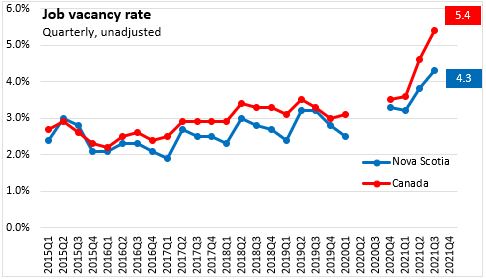
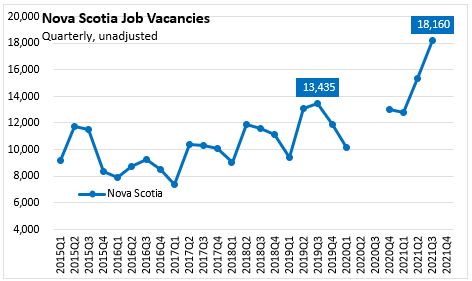
Across Canada, Q3 2021 job vacancy rates were highest in British Columbia and Quebec. The lowest job vacancy rate was reported in Newfoundland and Labrador. Compared to Q3 2019, vacancy rates increased for all provinces.
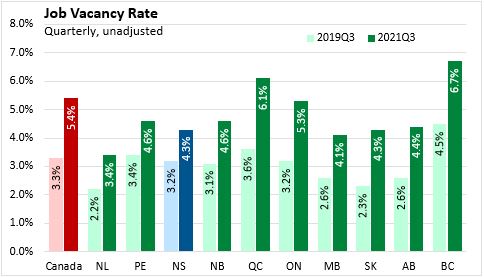
The average wage offered for a vacant position in Q3 2021 was $19.65 per hour in Nova Scotia, up from $17.65 in Q3 2019. The national average wage increased to $22.55 per hour from Q3 2019.

Compared with Q3 2019, the average wage offered increased 6.1% nationally. Average wages on vacant positions were highest in Ontario, Alberta, and British Columbia, and lowest in the Prince Edward Island and New Brunswick. Average wages offered on vacant positions increased in all provinces, except Newfoundland and Labrador.
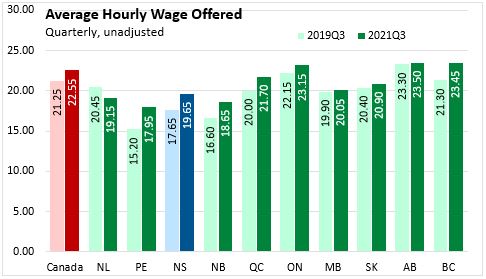
Among Nova Scotia's economic regions, Q3 2021 job vacancy rates were highest in the Annapolis Valley and lowest in Cape Breton. All regions had higher job vacancy rates compared to the same quarter in 2019.
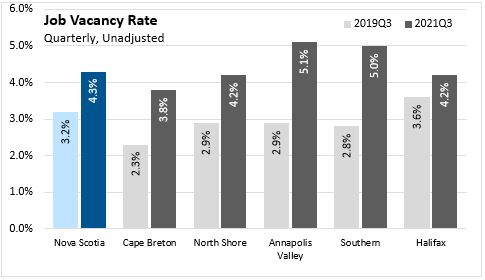
Compared with Q3 2019, average wages on vacant positions increased in all regions except the Annapolis Valley where they declined.
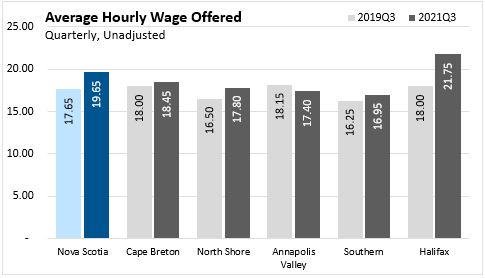
Across sectors with available data, Nova Scotia's Q3 2021 job vacancy rates were lower than the national average in every category except agriculture, forestry, fishing, transportation, real estate and rentals, professional and technical services, and education. Suppressed data are labelled as 'n/a'.

Compared to the national average, the wages offered for vacant positions in Nova Scotia were lower for all sectors in Q3 2021. The largest wage differences were found in construction, information and cultural, wholesale trade, and agriculture, forestry and fishing, and administrative and waste management.
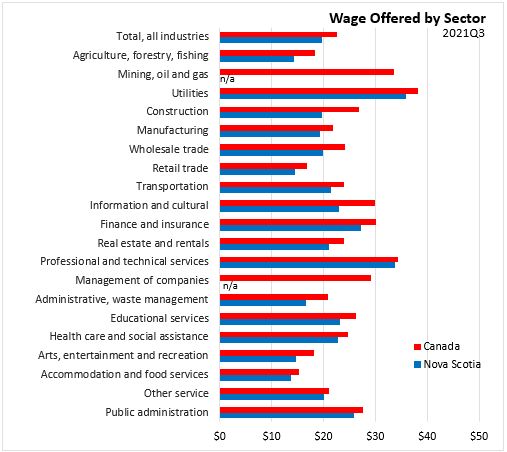
Across sectors with available data, Nova Scotia's job vacancy rates increased the most compared to Q3 2019 in accommodation and food services, agriculture, forestry and fishing, and arts, entertainment and recreation. Vacancy rates declined in health care and social assistance.

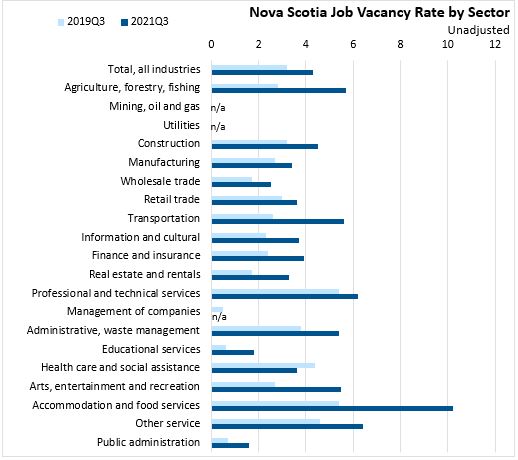
For sectors with available data, Nova Scotia's average hourly wages on vacant positions were highest in utilities, professional/technical services and finance and insurance. The fastest wage gains (Q3 2021 vs Q3 2019) were in professional and technical services, and real estate, rental and leasing. Average wages on vacant positions in education, agriculture, forestry and fishing, and public administration declined over this period.
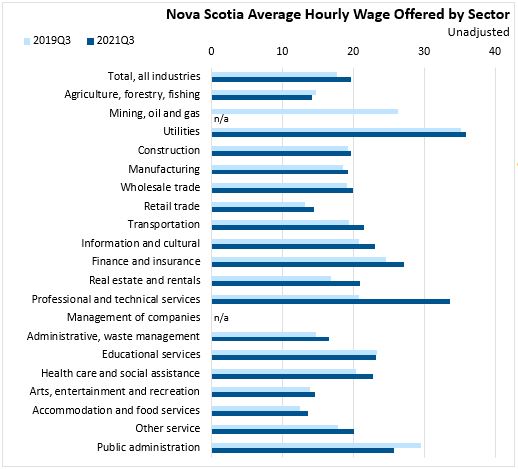
Of the 18,160 job vacancies reported in Nova Scotia during Q3 2021, the largest number (7,315) were in sales and service occupations. Sales/service vacancies increased 47.0% compared to the same quarter of 2019. Most occupation categories saw double-digit increases in the number of vacancies compared to two years ago except occupations in health or education, law, community and government services. Among occupations with data, vacancies were up the most trades and transportation and sales and services occupation.
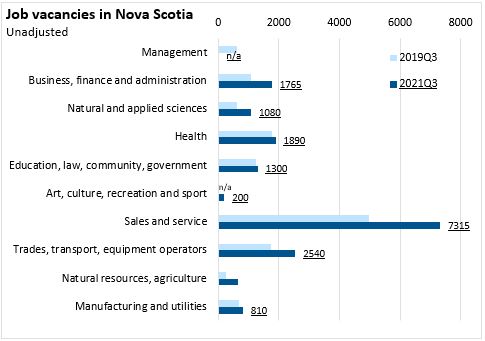
Average wages offered on vacant positions in Nova Scotia during Q3 2021 were highest for natural/applied sciences and health occupations. Occupations in sales and service and natural resources and agriculture had the lowest wages offered on vacant positions in Q3 2021.
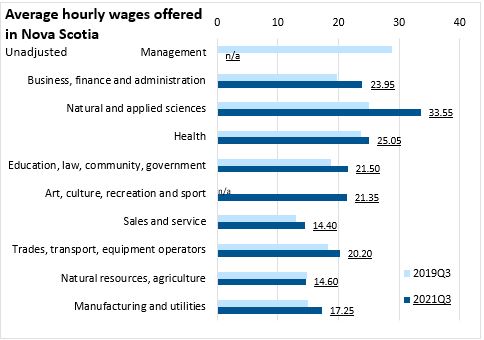
In Q3 2021, 66.1% of vacant positions in Nova Scotia required high school lower levels of education, up from 62.3% of vacancies in Q3 2019. Vacancies increased the most for positions requiring no minimum level of education.
Wages offered for vacant positions requiring high school or lower education were on average less than wages offered on vacancies requiring more education. The fastest growth in wages offered (compared to Q3 2019) were for positions requiring a high school education. Wages offered are up compared to the same quarter in 2019 for all education levels.
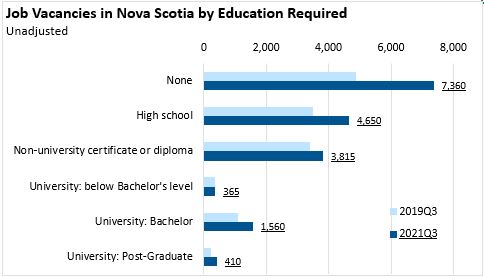
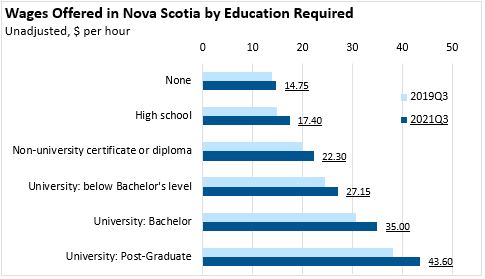
The number of vacant positions requiring less than one year of experience increased 48.2% (+3,670) compared to Q3 2019. The average wage offered on vacant positions increased for all required experience levels. The largest percentage gain occurred in jobs requiring 8 or more years of experience (+47.2%).
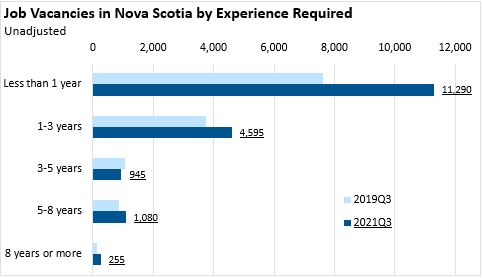
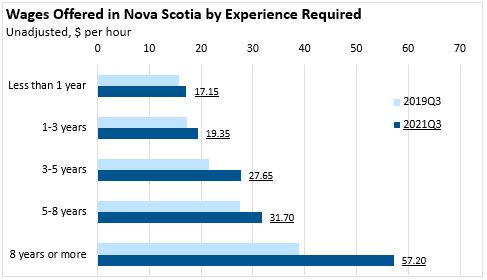
JVWS data are not seasonally adjusted. Therefore, quarter-to-quarter comparisons should be interpreted with caution as they may reflect seasonal movements.
Source: Statistics Canada.
<--- Return to Archive